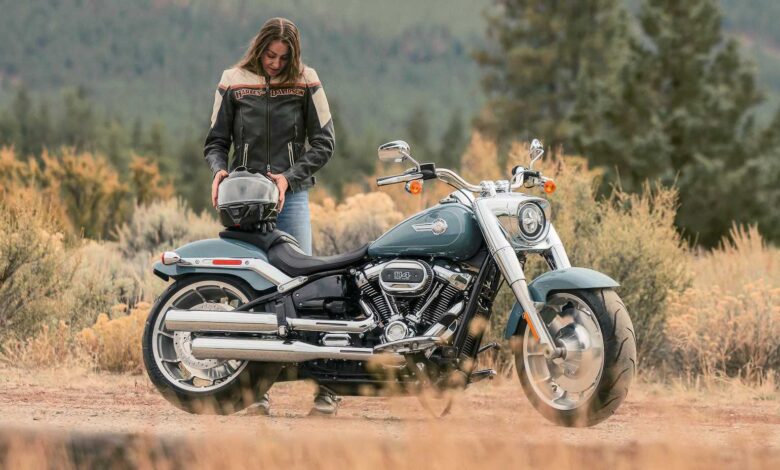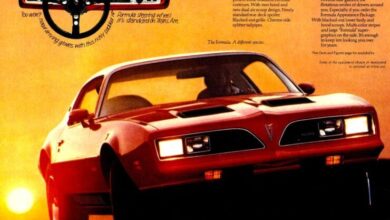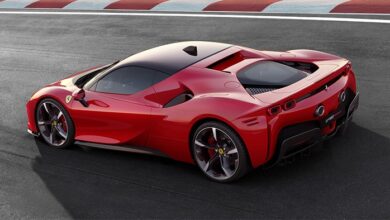The Harley-Davidson Fat Boy Is The Perfect Middle Ground Between Muscle And Mellow

Cruisers are easygoing, laid-back motorcycles that want you to take in the scenery, not just have it go past in a blur. That’s why they’re called ‘cruisers’, right? In recent times, though, the ‘sporty cruiser’ has emerged, which, if you think about the definition of a cruiser, sounds like an oxymoron. The sporty cruiser has caught on, though, so manufacturers will look to plug the gaps, as they always do.
That means having something that can double up as a laid-back boulevard bike, turning heads with its looks on a Saturday night, and then flash past and make people go “What was that?” on the highway on Sunday morning. There are a few good candidates, but not all of them can switch to either mode and be equal fun. There is one that stands above the others, not just because of its abilities and looks, but because it has a pedigree like few others as well. This is the cruiser that finds the perfect middle ground between muscle and mellow.
To give you the most up-to-date and accurate information possible, the data used to compile this article was sourced from Harley-Davidson and other authoritative sources.
The Harley-Davidson Fat Boy – Muscle And Mellow
Price: $22,599
The Fat Boy has been around for a while, and it has been very popular in that time. It looks great, and when launched, it was simultaneously different, and yet it met every expectation of what a cruiser should look like. That design has proven to be timeless, and Harley has wisely not messed with it. Meanwhile, the performance needs to keep up with the times, so it has received periodic updates to the driveline and running gear to make sure it doesn’t fall behind in the performance parameters. Today, it is powered by the Milwaukee Eight 117 engine, which has enough torque and performance to satisfy even the critics. Leave it in a gear higher than you need, and it will rumble along without complaint.
H-D has also given its entire Softail range a six-axis IMU, and the safety that goes with it is now standard, so along with that performance upgrade is now a safety upgrade that will allow you to extract the max from the Fat Boy. This means that the Fat Boy finds the perfect middle ground between muscle and mellow.
Why We Picked The Harley-Davidson Fat Boy
- Muscle – it’s called the ‘Fat Boy’ for a reason.
- Iconic design elements like the disc wheels have endured the test of time.
- A lot of power from the Milwaukee Eight 117 engine.
- Still a cruiser at heart, with loads of chrome and the ability to turn heads.
The 117 CI Engine Is New
Electronic Controls And Safety Are Good Features
The Fat Boy is a large cruiser, and it needs a large engine. Harley recognizes this, and has kept updating the engine over the years. It has got an update for the 2025 model year, and it is now powered by the Milwaukee Eight 117 Custom engine. This is an air-cooled engine, but it does offer more performance than the Milwaukee Eight 114 that it replaces. The output figures are now 104 horsepower and 126 pound-feet, and they arrive at a low 4,800 RPM and 3,000 RPM. There is a by-wire throttle with ride modes, so you can tune the throttle response to your mood – use ‘Rain’ mode when you’re feeling mellow, and ‘Sport’ mode will do nicely for muscle.
A six-speed gearbox and belt final drive complete the driveline. The by-wire throttle coupled with the six-axis IMU offers cornering traction control and back-torque limiting, which Harley calls ‘cornering enhanced traction control’ and ‘drag torque slip control’.
Harley-Davidson Engine Specifications
|
Engine Configuration |
‘Milwaukee Eight 117 Custom’ 45 degree V-twin, pushrod actuated OHV, 4 valves per cylinder |
|
Displacement |
1,917 cc |
|
Bore x Stroke |
103.5 x 114.3 mm |
|
Compression Ratio |
10.3:1 |
|
Power |
104 HP @ 4,800 RPM |
|
Torque |
126 LB-FT @ 3,000 RPM |
|
Fuel System |
Electronic sequential port fuel injection |
|
Transmission |
6-speed manual |
|
Final Drive |
Belt drive |
Harley-Davidson Fat Boy Chassis: Traditional Chassis
Backed Up With Modern Features And Electronics
The Fat Boy chassis is similar to the rest of the Softail lineup, with a downtube frame holding everything together. It has standard front forks from Showa with dual bending valves, and an underseat rear shock. The rear doesn’t have much travel, so you’re going to need a smooth road to enjoy it fully. The rear preload is the only parameter that can be adjusted, but it is a tool-free adjustment.
Harley-Davidson Fat Boy Chassis Specs And Dimensions
|
Chassis |
Downtube frame |
|
Front Suspension |
49 mm Showa dual bending valve forks, 5.1 inches travel |
|
Rear Suspension |
Showa hidden single shock with 1.7 inch stroke, tool-free hydraulically adjustable preload; 3.4 inches travel |
|
Front Tire And Wheel |
160/60 R18 |
|
Rear Tire And Wheel |
240/40 R18 |
|
Front Brakes |
300mm single disc with four-piston fixed caliper |
|
Rear Brakes |
292 mm disc with two-piston floating caliper |
|
Fuel Tank Capacity |
5.0 Gallons |
|
Length/Width/Height |
93.1/40/43.1 inches |
|
Wheelbase |
65 inches |
|
Rake |
30 degrees |
|
Trail |
4.1 inches |
|
Seat Height |
25.9 inches (laden) |
|
Ground Clearance |
4.9 inches |
|
Curb Weight |
694 LBs (wet) |
The brakes consist of a single 300 mm front disc with a four-piston fixed radial caliper and a 292 mm rear disc with a two-piston floating caliper. Sure, the six-axis IMU and dual channel ABS help mitigate a lot of the negatives, but you can’t escape the fat that this is an almost 700 pound bike. Bikes that weigh nearly half as much, like the KTM 390 Duke, have a larger front brake disc with a similar caliper. This is the only place you might find the Fat Boy wanting; when you’re hustling along, using its muscle. A tire pressure monitoring system is also present. An interesting fact is that the Fat Boy uses a non-standard wheel size; 18 inches at both ends. The only other cruiser that uses this size is the Suzuki Boulevard M109R.
Retro Looks, Modern Features
The Fat Boy is a model with a lot of heritage – over three decades’ worth – so it can’t alienate its fan base by going completely modern. Harley has already done this with the Sportster, but the Fat Boy caters to a different audience, and Harley can’t risk it with this model. It therefore keeps the feature set simple and as analog as possible. There is a tank-mounted instrument cluster with an analog speedometer and warning lamps. The rest of the information, like the fuel gauge, odometer, and trip meters, is displayed at the bottom in a reverse LCD display. Recently, the ‘Gray Ghost’ version was launched which is a throwback to the chrome-filled Fat Boys of the past.
Harley-Davidson Fat Boy Notable Features
- 5-inch tank-mounted analog/reverse LCD
- Three ride modes
- Cruise control
- Cornering traction control and ABS are present
- Adjustable front brake lever
- USB-C charging port
- Tire pressure monitoring system
The six-axis IMU is an important addition, as it adds a great layer of safety to the ride. There is also the tire pressure monitoring system, a USB-C charging port, and an adjustable front brake lever.
Harley-Davidson Fat Boy Competition
Some Usual And Some Not-So-Usual Suspects
The Fat Boy is a default choice, but for those looking for another cruiser that can do the slow cruise and hustle along over the weekend as well, there are a few options. The direct rival to the Fat Boy is the Indian Super Chief Limited. It is offered in light touring form, but it has the large-displacement air-cooled American V-twin and a sporty aesthetic. Another cruiser that does the retro/modern thing really well is the BMW R 18. It doesn’t offer the performance of the Fat Boy, but it is impressive for the new price.
Harley-Davidson Fat Boy vs. Rivals
|
Harley-Davidson Fat Boy |
Indian Super Chief Limited |
BMW R 18 |
Suzuki Boulevard M109R |
|
|
Price |
$20,499 |
$21,999 |
$15,395 |
$15,799 |
|
Engine |
45 degree V-twin, 4 valves/cyl |
49 degree V-twin, 2 valves/cyl |
Boxer twin, 4 valves/cyl |
52 degree V-twin, 4 valves/cyl |
|
Cooling |
Air cooled |
Air cooled |
Air/oil cooled |
Liquid cooled |
|
Displacement |
1,917 cc |
1,901 cc |
1,802 cc |
1,783 cc |
|
Power |
104 HP @ 4,800 RPM |
89 HP @ NA RPM |
91 HP @ 4,750 RPM |
123 HP @ 6,200 RPM |
|
Torque |
126 LB-FT @ 3,000 RPM |
120 LB-FT @ 2,900 RPM |
120 LB-FT @ 3,000 RPM |
118 LB-FT @ 3,200 RPM |
|
Gearbox |
6 speeds |
6 speeds |
6 speeds |
5 speeds |
|
Curb Weight (Wet) |
694 LBs |
739 LBs |
825 LBs |
764 LBs |
Finally, the Suzuki Boulevard M109R would have been our pick for this article if it hadn’t remained unchanged for two whole decades. It sorely needs some basic safety like ABS and traction control to back up the great mechanical bits it has. As is, it is one of the great price-to-performance deals available today.








